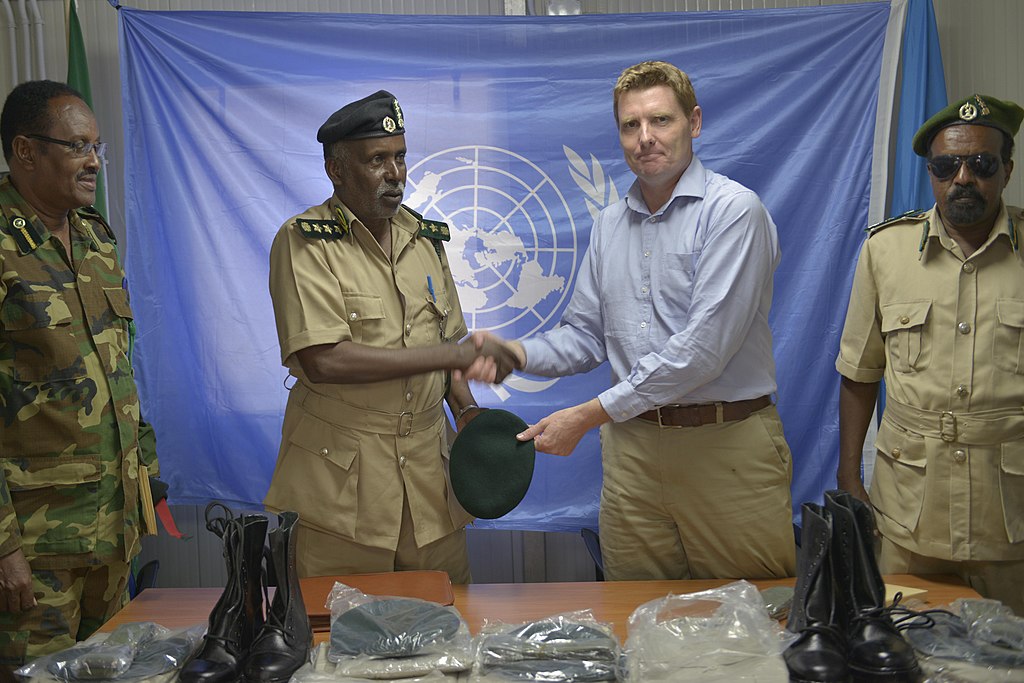
2014 02 19 Handover of Uniform to Somali Custodial Corps 07.
“All in all, drug trafficking is intensifying and constitutes a funding opportunity for crime and a threat to the security of states.”
On 11 January, the Burkina Faso-based Norbert Zongo Cell for Investigative Journalism in West Africa (CENOZO) wrote the attached, excerpted French-language article on criminal drug trafficking in the Sahel. CENOZO was founded by the United Nations Office on Drugs and Crime (UNODC) to report on corruption, organized crime, bad governance, and violations of human rights. According to the article, a number of factors are contributing to drug financing of terrorism in the region, including the lack of state authority, weak judicial systems, the collapse of the traditional pastoral economy, and corruption.
In particular, the article points to northern Mali as a transit point for cocaine in West Africa, which disrupts the stability of state institutions and benefits from the complicity of political or military figures. The article also notes that drugs often pass through the three coastal West African countries of Côte d’Ivoire, Ghana, and Togo and suggests that drug lords in Burkina Faso remain unknown and have evaded security forces crackdowns. Although the article acknowledges UNODC has launched several programs to counter drug trafficking, including surveillance at airports, the indifference and corruption of government officials has limited the ability of such programs to curtail the drug trade in the Sahel.
One of the drugs that the article highlights with concern is tramadol, often used by laborers. However, the northern Nigeria-focused news outlet Daily Trust noted in a 5 June article that the Nigerian National Drug Law Enforcement Agency (NDLEA) has intercepted tramadol shipments from the coastal city of Lagos. These were destined for Boko Haram in the country’s northeast. The drug is used to keep fighters awake and vigilant during long battles or when hiding in the bush to evade security forces.
Besides high-level officials and militant group involvement in the drug trade, the article argues the abuse of drugs by impoverished youth can also result in their being recruited by armed groups. Consistent with previous reporting from as early as January 2014 by the Geneva-based Global Initiative Against Transnational Organized Crime, the excerpted article by globalinitiative.net states that the origin of some of the drugs in the Sahel is Latin America, including Colombia and Brazil, as well Bombay, India. Therefore, the problem of drug trafficking and its inter-relation with terrorism and militancy in the Sahel remains complex, with distinct local and global factors contributing to its perpetuation.
Source:
“Burkina Faso, Mali, Niger: Sur les routes criminelles de la drogue au Sahel (Burkina Faso, Mali, Niger: On the criminal drug routes in the Sahel),” cenozo.org (UN sponsored media consortium based in Burkino Faso), 11 January 2022. https://cenozo.org/burkina-mali-niger-sur-les-routes-criminelles-de-la-drogue-au-sahel/
Several types of drugs transit through Burkina Faso, Mali and Niger, with Europe as their destination. Facilitated by porous borders and insufficient means of control, this traffic fuels crime in the Sahel. Between January and October 2021, Burkina Faso customs seized at least 78.11 tons of drugs.
Tramadol is trafficked for non-medical use and is widely consumed by people performing physical work: gold miners, agricultural producers, workers on major construction sites. Its trafficking constitutes a great threat in West, Central and North Africa, underlines the UNODC.
The drugs usually come from Bombay in Asia and Colombia and Brazil in Latin America. UNODC describes the Sahelian region as a trade and migration route where “the lack of state authority, weak judicial systems, the collapse of the traditional pastoral economy, corruption and the presence of fire have created an ideal conducive environment for illicit trafficking, organized crime, terrorism, corruption and money laundering.” The UNODC cites Mali in its 2013 report as one of the main transit countries for cocaine in West Africa, combining several related activities that dangerously disrupt the stability of institutions.
Source: “Illicit Trafficking and Instability in Mali: Past, Present and Future,” globalinitiative.net (Geneva based civil society organization), January 2014. https://globalinitiative.net/wp-content/uploads/2014/01/Illicit-Trafficking-and-Instability-in-Mali-Past-present-and-future.pdf
Cocaine first entered these networks in 2002, after South American wholesalers began using West African ports as an intermediate step in reaching consumers in Europe. The consequent rise of organized criminal syndicates in coastal states such as Nigeria and Ghana gained the attention of international bodies and policymakers. Although some amount of cocaine arrives by boat or plane directly to Mauritania and Morocco, the main ports of entry for South American wholesalers to the region are still believed to be Guinea and Guinea-Bissau.
Source: “NDLEA Seizes 34,950 Tramadol, Diazepam Capsules Enroute To Boko Haram,” dailytrust.com (news outlet covering social and political affairs of northern Nigeria), 5 June 2021. https://dailytrust.com/ndlea-seizes-34950-tramadol-diazepam-capsules-in-lagos
Spokesman of the agency, Femi Babafemi said in Abuja that a 25-year-old, Mohammed Isah, was recruited to move the drugs from Lagos to Borno was arrested. The suspect claims he accepted the offer because of the monetary benefit due to pressure on his finances as his wife and three children displaced by Boko Haram activities.
Image Information:
Image: 2014 02 19 Handover of Uniform to Somali Custodial Corps 07.
Source: AMISOM Public Information https://commons.wikimedia.org/wiki/File:2014_02_19_Handover_of_Uniform_to_Somali_Custodial_Corps_07_(12632984573).jpg
Attribution: CC x 2.0
